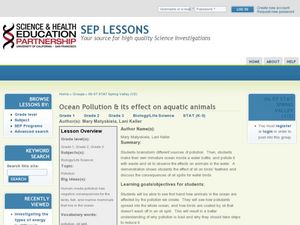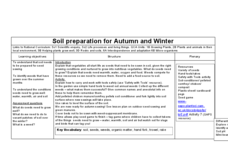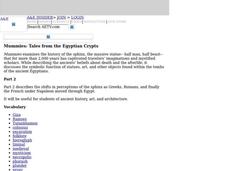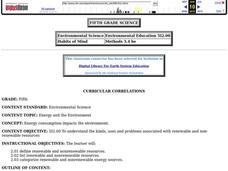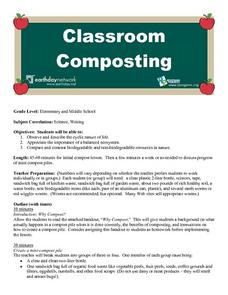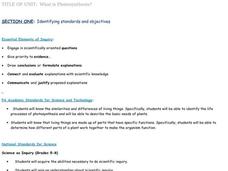Curated OER
Hedgehog
In this hedgehog worksheet, students read information paragraphs about the habitat, reproduction, feeding and adaptation of hedgehogs. Students study the photograph of the mammal. There are no questions to answer here.
Curated OER
Ocean Pollution & its Effect on Aquatic Animals
Students consider the concept of ocean pollution. In this ocean instructional activity, students participate in a hands-on demonstration in order to replicate an oil spill and its effects on marine life.
Curated OER
Flowering Phenology: How Do Plants Know When to Flower?
Students study the process of plant reproduction and the biotic and abiotic factors that affect flowering phenology. In this plant reproduction lesson, students describe the interaction of environmental factors as it relates to...
Curated OER
The Electric Sieve
Students examine different mixtures and how they can be separated. In this electric sieve lesson students complete an activity that allows them to separate mixtures.
Curated OER
Orca United Nations
Students study the differences between sets of data and explain how organisms are adapted to their environment. In this marine mammals lesson students analyze data based on set criteria.
Curated OER
Biotechnology: Monster or Miracle
Students explore biotechnology. For this scenario-based lesson, students take a survey on what they know about genetic engineering, view a PowerPoint, and conduct a web quest. Students will then be placed in groups, and produce one of...
Curated OER
Is There A Fungus Among Us?
Sixth graders classify fungus into two different groups. In this fungus lesson, 6th graders collect as many pieces of fungus as possible. Students then classify these pieces of fungus as saprophytic or parasitic.
Curated OER
Soil Preparation for Autumn and Winter
Students determine how and why soil needs to be prepared for the fall and winter seasons. In this agriculture lesson, students determine how to use gardening tools safely. They show how to work with compost material and fertilizer to...
Curated OER
Mushroom
Students identify the different types of mushrooms. In this biology lesson, students explore different mushroom experiments they can do at home. They discuss ways to extend sliced mushrooms' shelf life.
Curated OER
Grapevine Magic
Students explore plant uses. Students observe the process of changing grapes to raisins as a method of preserving a plant part for human use.
Curated OER
Mummies: Tales from the Egyptian Crypts Part II
Students explore the shifts in perceptions of the sphinx as Greeks, Romans, and finally the French under Napoleon moved through Egypt.
Curated OER
A SALT WATER-Y WORLD
High schoolers observe a model of the distribution of the earth's water and compare the relative volumes and percentages of types of water on earth.
Curated OER
What Bees Eat
Students consider the concept that plants and animals are dependent on one another and role-play the interaction between bees and flowers. They identify crops that are dependent on pollination by bees.
Curated OER
Cougar or Human: Which Needs Protection?
Students research the biology and natural history of the cougar. Students conduct Internet research to determine how cougars have been protected by humans and how it is affected by human decisions. Students write about reconciling...
Curated OER
Energy and the Environment
Fifth graders define terms associated with renewable and nonrenewable resources. They identify materials that are renewable and nonrewable. They categorize a list into the correct type of resource.
Curated OER
Classroom Composting
Students discover the benefits of composting. They identify the steps of decomposition as well. They are read a book and discuss what items decompose.
Curated OER
Plant Pollination and Fertilization
Fourth graders research and apply knowledge about plant pollination and fertilization in this lesson. They color on a flower diagram the anther, the pistil, the pollen, the pollen tube, the ovary, and the egg to show the process of...
Curated OER
What is Photosynthesis?
Students investigate the similarities and differences of living things. Specifically, students will be able to identify the life processes of photosynthesis and describe the basic needs of plants.
Curated OER
Insect Challenge Project
In this biology instructional activity, students identify insects by their name and write it in the correct box on the sheet. Then they catch insects with nets and bring them in to identify. Students also earn points for the number of...
Curated OER
Making Ammonia - The Haber Process
In this fertilizer worksheet, high schoolers read background information about how farmers began using nitrogen compounds as fertilizer and how Fritz Haber came up with an efficient process. Students complete 10 short answer questions...
Curated OER
What Bees Eat
Students study plant and animal interdependence by studying bees and pollination. In this interdependence lesson, students discuss flower parts and dissect it to show its reproductive parts. Students then use tissue and pipe cleaners to...
Curated OER
All Hands on Deck: A Harbor Education Program
Pupils build a model of an estuary. In this wetland instructional activity, students build a model estuary with a paint tray and modeling clay. They use the model to illustrate the impact of non-point pollution on the watershed.
Curated OER
Diet, Exercise and AIDS
Students research AIDS and the role of diet and exercise with the disease. In this AIDS lesson, students listen to a mini lecture about the diet and exercise needs of people who have AIDS. Students learn about alternative therapies to...
Curated OER
Where's the Point?
Students examine runoff for the causes, the impact, and the solution. In this investigative lesson students construct a three dimensional model of a watershed and provide information of contaminated runoff to their audience.



